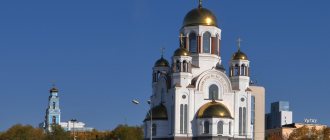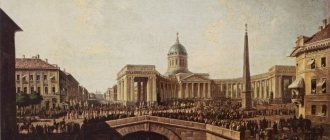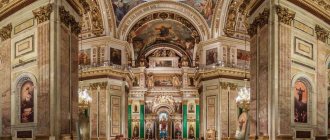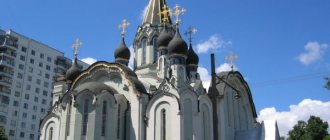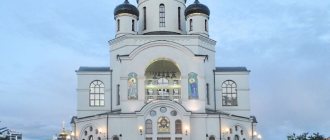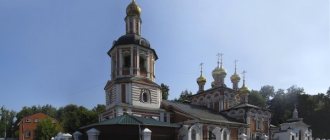Where is the Resurrection Smolny Cathedral located in St. Petersburg
The cathedral is located in a picturesque place, chosen by Elizabeth herself: on the left bank of the Neva, not far from her native palace. Now you can find it on Rastrelli Square, 1.
The palace got its name because of its location. Previously, the production of resin for ships was organized there. Tradition says that Elizaveta Petrovna, in her youth, decided to end her life in a quiet monastery, but this was not destined to happen. She chose a place for the monastery not far from her home palace.
How to get there by public transport
The complex, designed by Rastrelli, is located at a decent distance from the metro, although it is located in the city center. If you need to get to the cathedral quickly and don’t have time to walk for half an hour, you can take the bus. The routes run regularly, so you won't have to wait long.
From the Chernyshevskaya metro station to the cathedral there are routes 22, 46 and trolleybus 15. From “Uprising Square” there are buses 22 and trolleybuses 7.5.
How to get there
The temple is located between the Chernyshevskaya and Ploshchad Vosstaniya metro stations, at the address: pl. Rastrelli no. 1.
True, he stands quite far away from both of them. Therefore, I advise you to resort to the help of other urban transport:
- from metro station "Chernyshevskaya" - buses No. 46, 22, trolleybus No. 15;
- from metro station "Ploshchad Vosstaniya" - bus No. 22, trolleybuses No. 5, 7.
However, I usually just get here at a quick pace, so I also attach a map of the walking route from the Chernyshevskaya metro station (1) to the cathedral (2):
History of the Cathedral of the Resurrection of Christ
The cathedral was erected by order of Elizabeth, the daughter of Peter. At a young age, she decided to spend her adulthood within the walls of the monastery. Elizabeth treated its location with all responsibility, since the beauty of buildings and landscapes at that time was in the first place. She chose the area on the left bank of the Neva, not far from her native palace.
The temple was built from 1748 to the 1820s, which took 87 years. This is the longest construction period in all of St. Petersburg. Rastrelli himself began the construction, and Stasov finished it.
Long construction is due to a list of factors:
- lack of funding, all the money was invested in military uniforms and weapons;
- martial law;
- after the war, Elizabeth was not eager to go to a monastery and did not rush construction;
- Rastrelli's death, he never saw the finished cathedral.
The cathedral is consecrated as a cathedral for all students. To this day, he retains this status. In 1765, study groups for girls of high birth were organized. In 1808, the first girls began studying. Smolny became the world's first educational institution for ladies and for many years retained its status as a prestigious institution.
Construction of the cathedral
The order was transferred to B. Rastrelli, it was said to create a temple of unprecedented beauty and grandeur with the highest bell tower. For Rastrelli, the construction of the cathedral was the highest achievement in the life of the chief architect. He adhered to the Baroque style in his architectural buildings. His works of art still decorate St. Petersburg today, like airy cakes.
The implementation of the plan took about 4 years. The project underwent a lot of changes, which again and again delayed the start date of construction of the cathedral.
The temple is located in the center of the composition of the entire complex and has a height of almost 100 m. The weighty base in combination with the sophisticated and “light” top creates a feeling of lightness and airiness of the entire cathedral.
Construction was constantly slowed down. At first, Rastrelli could not find a common language with the foreman. Then, a year later, Elizabeth begins to make her own changes to the project, which slow down the process of building the temple even more. She decides to replace the one-domed cathedral project with a five-domed one, thereby returning the ancient Orthodox canons of temple construction to St. Petersburg.
In 1750, the creation of the model began, which lasted 6 years. The complex was made of wood; builders could use it to check the process of constructing the temple. A whole ensemble with a large bell tower was planned. Today the model is kept in the Academy of Arts Museum.
The Smolny Cathedral in St. Petersburg is being built by the best carpenters and workers. A lot of money was spent on the construction of the temple. Rastrelli develops his own Baroque, which is slightly different from the European one. It decorates the temple on each side, while Europe gave more importance to the facades of buildings.
The architect, when creating the project for the complex, wanted to implement a project for a high 5-tier bell tower next to the cathedral. The bell tower, almost 100 m high, would be the tallest in Russia. But martial law reduces the financial capabilities of the state. Over time, Elizabeth's desire to become a nun fades away. Without waiting for the consecration of the cathedral, she dies in 1761.
Rastrelli died in 1771, having previously canceled the bell tower project, since it would not fit into the overall composition of the monastery. Rastrelli himself died without seeing the completed cathedral.
Catherine II comes to power. She chooses Felten, who created the Hermitage, as the chief architect.
Felten is engaged in the construction of buildings, but as soon as he begins to work on the interior of the main temple, funding for construction stops again. Catherine II creates a school for girls of noble and bourgeois origin, they lived in the Smolny Monastery. Then the monastery already sheltered 20 nuns within its walls.
In 1797, the monastery was abolished by order of Paul I. Construction of an institute began, where ladies of noble blood would study. Monastic monasteries become the Widow's House.
Construction was completed only after Nicholas I came to power. Stasov wins the architects' competition, continuing the construction of residential buildings and finalizing the interior decoration of the temple. Construction was completed in 1835.
In general, the cathedral took longer to build than any building in St. Petersburg, as much as 87 years.
| Year | Events that took place |
| 1748 | Construction of the temple begins. |
| 1750 | Creation of a layout of the complex. |
| 1761 | Death of Elizabeth, Catherine II comes to power. |
| 1771 | The architect Rastrelli dies. |
| 1797 | The monastery is being abolished. |
| 1835 | Completion of construction and consecration of the temple. |
Before the 1917 revolution
Before the start of the revolution, a service was held in the temple every day. The temple annually celebrated August 4 - the day of Mary Magdalene. The entire royal family came to the solemn event every year.
Students from various educational institutions from all over the city were often invited to the monastery. During its entire service, the Smolny Cathedral saw many rectors, the last of them was Andrei Yurashkevich. In St. Petersburg, after the revolution, all churches were closed.
After the 1917 revolution
In 1917, the institute became a meeting place for deputies. The headquarters and the military revolutionary committee, which was engaged in the overthrow of the Provisional Government, will be organized in the building. Later, Lenin would lead the uprising straight from the Smolny Institute.
On the morning of October 25, all strategic objects were in power, including bridges and all train stations. By evening, the Winter Palace, where the Provisional Government was located, was stormed. The revolution ended in victory.
The Institute is now the seat of the All-Russian Central Executive Committee. Lenin himself lived here from 1917 to 1918. After which the institute again became a meeting place for deputies.
During the war, the Smolny Cathedral in St. Petersburg was not damaged
- In 1927, a monument to V.I. Lenin was erected in honor of the 10th anniversary of the revolution.
- in 1923 the Smolny Cathedral was closed and a warehouse was organized inside.
- In 1972, the iconostasis was removed from the temple. The fact that it survived for such a long period of time can be considered a real miracle. All other valuables and icons were also confiscated and sent to museums.
- 1974 - opening of a museum inside the cathedral.
- 1990 – opening of the concert and exhibition hall.
- Since 1991, the institute has housed the mayor's office. Today, the city administration works here and the residence of the city governor is located.
Cathedral today
The Smolny Cathedral in St. Petersburg has come a long way, from protracted construction lasting almost 100 years to the great upheavals associated with the revolution. Today, the cathedral is again open to Orthodox believers. Divine services are held here every day, prayers and sermons are read.
Now the temple is a cultural center. The exhibition hall of the cathedral hosts art and scientific exhibitions, conferences, and organ concerts. Daily services have resumed. The temple is open to everyone from 7 am to 8 pm every day. Admission is free, only the excursion ticket is paid.
The special acoustics of the concert hall attracts new visitors. During concerts, music by Vivaldi and Prokofiev is played here. The chamber choir sings and the cathedral exhibitions are open. Conferences are held regularly.
2009 – the first prayer service in the church after the revolution.
Since 2010, the temple has reopened to believers; the day is marked by the first liturgy, sung after the silence of the temple for 87 years. Nowadays services are held daily. But some rooms and halls of the cathedral are still in the possession of the state, and cultural events are held there.
Since 2010, you can listen to live organ music here; concerts are held regularly. The ancient throne, located in the temple today, was given as a gift from the Kazan Cathedral.
2013 - a large bell weighing 10 tons was cast, it was brought from Voronezh and consecrated in St. Petersburg. In 2015, the temple came under the authority of the Russian Orthodox Church.
A Sunday school for children is organized at the temple. In addition to it, the Smolyanka School has been created, where girls are taught the manners and traditions of the Institute of Noble Maidens. Girls are taught manners, handicrafts and etiquette, which is a worthy tradition.
For boys of the same age, the Corps of Pages is organized, where children learn history, traditions, learn the art of fencing and learn to ride a horse. Each child has a military uniform, which is issued upon admission.
Upon completion of training, ceremonial balls are held, where young ladies waltz with little knights. From a young age, children take an active part in charity, organizing exhibitions and donating funds to orphanages, hospitals and nurseries. Spiritual conversations are held for adults every Sunday.
Smolny Cathedral
This is one of the most beautiful church complexes on the territory of modern St. Petersburg. And only the distance from the historical center prevents it from becoming a “must-see” for every tourist.
Not far from the place where they began to build the monastery complex there was a resin yard where resin for ships was boiled, which is why the monastery got its name Smolny.
Construction began on the orders of Empress Elizabeth, daughter of Peter the Great, who decided to retire and become a nun.
This historical version has no more right to life than other myths written by court “historians”. It raises strong doubts among anyone who is not too lazy to compare HOW the empress came to power and “the decision to retire from the bustle of the world.” The daughter of Tsar Peter, who took the throne by force, at the bayonets of the Preobrazhenskaya Company, and voluntary monastic seclusion? Oh well…
If this is not enough, let us recall that the reign of Elizabeth was considered by contemporaries as a period of luxury and excess. Masquerade balls and so-called “metamorphoses” were regularly held in the royal palaces. This is when ladies dressed up in men's suits, and men in ladies' suits. Today such liberties are called “non-traditional orientation”, but in those days only the queen could get away with such things. What kind of tonsure are we talking about? The queen herself was an ardent fashionista and her personal wardrobe consisted of almost 15 thousand dresses. Is this the image of a humble parishioner?
It is more realistic to say that, remembering the risky fate of the Russian tsars, Elizabeth started a rumor about her monasticism in order to extinguish the desire of possible conspirators to act immediately. Why stage a coup and risk your head if the queen is about to take monastic vows?
Of course, for the construction of “such” a monastery, in which she was supposedly going to become abbess, Elizabeth chose the most beautiful place.
By the way, here nearby on the left bank of the Neva, where the palace in which she spent her youth previously stood.
Having been drawn into political life, court intrigues and war, the empress gradually forgot her initial plans to enter a monastery, and the Smolny Monastery became the largest unfinished construction project in St. Petersburg.
Financing was stopped 10 years after the start of construction under the plausible pretext that the war with Prussia had begun and there was no money in the treasury.
The cathedral began work unfinished after the death of Elizabeth, and the work was finally completed 87 years later.
During this time, six rulers changed on the Russian throne!
Construction began with the Smolny Cathedral, which, according to the design of the architect Rastrelli, was located in the center of the monastery courtyard, and a five-tier bell tower, the tallest in Russia, was to be built nearby.
It was supposed to rise 18 meters above the spire of the Peter and Paul Cathedral. But the plans could not be implemented, Rastrelli died before the construction of his creation was completed, and his followers decided that the architectural ensemble of the city should not be disturbed by such a tall building.
In 1748, the cathedral was consecrated in the name of the Resurrection of Christ.
The cathedral, like the entire architectural ensemble of the Smolny Monastery, is decorated in blue and white colors.
The walls, decorated with white stucco, are painted blue. This gives the entire monastery a beautiful festive look.
Rastrelli's project assumed a single-domed temple, according to European traditions, which Peter loved, but Elizabeth insisted on a five-domed temple. She adhered to original Russian traditions.
The temple itself is crowned by the middle dome, and the other four are bell towers.
The entrance to the monastery territory is decorated with porticoes. The fence deserves special attention.
This is a real work of art, created according to a drawing by architect Stasov. The same Stasov also supervised the interior decoration of the temple.
The interior decoration is simple and solemn.
The central hall, which housed three magnificent iconostasis, was decorated with marble. The pulpit is a work of carved art.
After the revolution, the Smolny Cathedral was looted, and the premises were given over to a warehouse.
The iconostasis and relics, of which two icons by Venetsianov have survived, as well as all the property of the temple were transferred to museums.
Nowadays a concert and exhibition complex is open here.
Some of the buildings continue to be occupied by the city authorities. This is why city guides devote a lot of space to the Smolny Cathedral, and almost nothing about the full complex of the Smolny Monastery.
St. Petersburg, Rastrelli Square, houses 1-3
The nearest metro station is Chernyshevskaya.
It's quite a long walk, but from Chernyshevskaya the transport is not very reliable and travels far from the cathedral.
It is better to go from the metro station Ploshchad Vosstaniya.
After exiting the metro, turn left along Ligovsky Prospekt, walk to the Oktyabrsky Concert Hall, where you can take the K-76 minibus. This minibus reaches Rastrelli Square and turns onto Shpalernaya Street. This is where we need to get out.
Museums Palaces Cathedrals, churches Gardens, parks Bridges Monuments
Cathedral architecture
The monastery complex resembles a cross in plan. The main five-domed temple occupies the central part of the complex.
4 churches built into the wall of residential buildings that surround the cathedral, including the Nevskaya Church, create the ensemble of the Smolny Monastery. The belfry of the temple also acts as an observation deck for tourists; its height is more than 50 meters.
The garden of the Smolny Cathedral is distinguished by its beauty; there are 4 identical fountains inside. Flowers and trees bloom in the garden, and there are several cherry blossoms. Next door is the Smolny Institute, intended for ladies of noble and bourgeois blood. Currently, it houses the city administration.
The entire complex was created in the same style - Elizabethan Baroque, which was popular at that time , the walls are covered in blue with a lot of white stucco as decoration. The domes of the temple are painted light gray.
The temple is at the head of the entire complex, and in the corners of it there are 4 churches. Rastrelli wanted to build a single-domed cathedral, as was customary in Europe. But Elizaveta Petrovna wanted to see a five-domed cathedral, as is customary in Orthodox construction. The largest central dome is part of the temple, the other 4 are bell towers, which were added by order of Elizabeth Petrovna.
To make the temple fit better into the buildings of the Smolny Institute, its lower part was designed in the likeness of palaces of that time.
The Smolny Cathedral in St. Petersburg is made in the Baroque style. It absorbed European architecture, which combined with ancient Russian architecture, and a real work of art emerged. The combination of azure walls with white stone stucco creates a special elegant look for the cathedral.
The unique wrought-iron fence that completely surrounds the Smolny Monastery complex adds elegance. The fence was created by the architect Stasov, who completed the interiors of the temple after Rastrelli.
Concert Choir of St. Petersburg
In 1991, a chamber choir was created, which was organized on the basis of the concert and exhibition hall. It received the name of the Chamber Choir of the Smolny Cathedral. When the cathedral was transferred to the church, the choir changed its name because it lost its meeting place. Since 2021, it has been named the Concert Choir of St. Petersburg.
The choir, headed by Vladimir Begletsov, spent a long time looking for a new location, and, in the end, it was offered a hall in the building of the pre-revolutionary City Duma on Nevsky Prospekt.
Interior decoration
V. Stasov was already in charge of the interior decoration. He won an architectural competition. He suggested making the interior without frills in the Empire style, but decorating it with stucco. Now the cathedral is decorated with angels, lush bas-relief compositions and a lot of amazing details, each of which has its own meaning.
The interior is distinguished by its simplicity and grandeur. Rastrelli planned to create many baroque decorations, statues, and decorations, but they were either not completed or have not survived. Stasov decided to highlight Rastrelli's layout and not overshadow it with his decorations. The interior was based on the Church of Alexander Nevsky, the decoration of which was worked by G. Quarenghi.
Materials such as marble and crystal were used. The church hall is large in both area and height. The pulpit is decorated with carvings.
In the decoration of the cathedral you can see the elements of air and water, they are presented in the form of angels, clouds and rocaille. The interior contains elements of earth and air; the earth is represented by various flowers.
Baroque is characterized by the expression in symbols of force or fire, in the form of lions and warring angels. But in the entire cathedral they are absent according to Rastrelli’s idea.
Shrines of the cathedral
Two famous icons of A. Venetsianov have been preserved; they represent the main shrines of the temple. The first icon depicts the resurrection of Christ, the second the entrance to the temple of the Blessed Virgin Mary. The icon of the Mother of God can be seen in the Russian Museum. Until 1972, the temple was decorated with an iconostasis, which was dismantled by order.
The Smolny Cathedral in St. Petersburg has preserved a medal, on one side of which the cathedral itself is depicted, and on the other, Jesus Christ walking with children.
Orthodox churches, churches and organizations nearby
Transfiguration Cathedral
St. Petersburg, Central, Preobrazhenskaya square, 1
Armenian Apostolic Orthodox Church of St. Catherine
St. Petersburg, Central, Nevsky Prospekt, 40-42
Atrium
St. Petersburg, Central, Romenskaya street, 12
Temple of the Tikhvin Icon of the Mother of God
St. Petersburg, Central, Ligovsky prospect, 128
Exaltation of the Holy Cross Cossack Orthodox Cathedral
St. Petersburg, Central, Ligovsky prospect, 128
Candlemas
St. Petersburg, Central, Ligovsky prospect, 128-B
Cathedral of the Resurrection of Christ
St. Petersburg, Central, Griboedova Canal embankment, 2-A
St. Petersburg Diocese of the Russian Orthodox Church
St. Petersburg, Central, Monastyrka River embankment, 1
Coordination Center for Combating Drug Addiction and Alcoholism of the St. Petersburg Diocese
St. Petersburg, Central, Monastyrka River embankment, 1
Smolny Cathedral
St. Petersburg, Central, Rastrelli square, 1
Rules for visiting the cathedral
The cathedral is active and entry is free. A ticket for the excursion costs 250 rubles. At the same time, pensioners and students can take a tour of the architectural monument for only 50 rubles, children under 18 for 150 rubles. You can buy a ticket at the box office or on the website from 7:00 to 18:00.
When entering the temple, it is advisable to observe the culture of visiting the cathedral, dress according to the canons, not wear makeup, remove all frilly jewelry, behave modestly and quietly, without disturbing others. Girls enter the temple with their heads covered and in a long skirt, young people take off their headdress and put on a formal suit or dull clothes.
Interesting facts about the Cathedral of the Resurrection of Christ
- To build a model of the temple at the site of its construction, it was necessary to cut down the walls in 4 rooms. The best carpentry masters were invited to construct the wooden model. The model was erected in the same sequence as the cathedral itself.
- If the five-tier bell tower were built, the main bell would weigh 327 tons. The largest “Tsar Bell” is 200 tons.
- During the restoration, secret passages were found leading to Chernyshevskaya Street.
- The bomb shelter in the basements of the Smolny Cathedral was the first in Russia.
- As you approach the temple, it may seem that it is decreasing in size. This effect was created thanks to the skill and skill of the architect.
- The author of the Smolny Institute project saluted the architect Rastrelli all his life, each time taking off his hat in front of the Smolny Cathedral and giving him a respectful bow.
- The cathedral seats more than 6,000 people.
- Construction of the cathedral took 87 years. Services were carried out for 87 years. After the revolution, exactly 87 years passed before the first prayer service in the temple. Numerology interprets the number 87 as a shield and a sword.
- Many eyewitnesses notice a certain silhouette of a lady in white walking through the territory of the Smolny Monastery.
- In guidebooks, the name of the point is indicated as “Smolny Cathedral”, and not “Smolny Monastery”, this is due to the fact that many premises of the complex are still occupied by government agencies.
- It was believed that the temple was cursed and it was for this reason that its construction took more than 80 years. During the construction of the complex, one of the assistants committed suicide right in the temple. The workers said that they saw his wandering ghost for a long time. And the temple needed to be cleansed after committing a sin, which is why the construction process took so long.
- Smolyanki are girls studying at the Smolny Institute. They say that they often saw the ghost of a man with a business briefcase, most likely this is the same assistant to the architect. The ghost could simply stand in the corridor and then disappear into the wall.
Rastrelli created a lot of beautiful architectural creations in St. Petersburg, in addition to the Smolny Cathedral. Buildings and temples in the form of airy cakes or fairy-tale castles are quite normal for people of that time.
It is better to come to the city for at least 5 days in order to have time to enjoy all the works of famous architects, visit the parks and palaces of the former nobility, and feel at least for a minute as part of something great.
Everyone needs to visit the Smolny Cathedral and feel the atmosphere of the bygone times of St. Petersburg, when luxury reigned in the city and spiritual joy flourished.
Article design: Mila Friedan
The Cathedral today
As long as the period of its construction was, the road to finding its true purpose turned out to be just as difficult. Today this wonderful Cathedral of the Resurrection of Christ is a functioning Orthodox church.
On May 24, 2009, on the day of teachers Cyril and Methodius, the rector of the Theological Academy of St. Petersburg, Bishop of Gatchina Ambrose, served here the first prayer service after spiritual oblivion.
In 2010, under the arches of the Smolny Cathedral, the liturgy sounded again.
And here are the amazing coincidences of history again! The cathedral took 87 years to build. And after the revolution of 1917, exactly 87 years later, the concert chairs were finally removed from the right side of the Catherine’s church. Now more than a thousand believers could attend the service here. And this event was a real triumph. On the day of the Annunciation, April 7, the solemn festive divine service was led by the Metropolitan of St. Petersburg and Ladoga Vladimir (Kotlyarov) himself.
An ancient throne was given here as a gift from the Kazan Cathedral. A copy of the altarpiece of the Blessed Virgin Mary written by A. Venetsianov was created (the original is in the State Russian Museum).
Now Sunday services within this limit have become regular. In the same year, in memory of the 175th anniversary of the temple, the St. Petersburg mint issued a special medal.
In 2011, the first Christmas service was held here.
In 2013, a bell weighing 10 tons, made in Voronezh, was delivered here and illuminated.
On January 25, 2015, the Smolny Cathedral was completely transferred to the jurisdiction of the Russian Orthodox Church. Yes, it is on January 25 that the cathedral regains its true purpose. And this happened on a holiday famous among students - St. Tatiana’s Day.
This probably did not happen by chance. The fact is that the cathedral historically became the temple of educational institutions of the Northern capital. It is not surprising that his priority is the spiritual and moral education and enlightenment of youth.
Since 1997, in St. Petersburg, on the initiative of universities and universities of St. Petersburg, its highest Theological school - the Academy, various public organizations and the Youth Policy Committee, an amazing Tatyana creative competition began to be held. Both students themselves and their mentors have been taking part in it for 20 years.
Today the competition is headed by the Pokrov association, which includes 25 universities in the Northern capital, its Interuniversity campus and Tver State University. This association seems to have two “wings” - spiritual and secular. On January 25, after the solemn liturgy, according to tradition, the winners of the competition are awarded in the Smolny Cathedral.
Students who have particularly demonstrated themselves in service to society and educational work receive Honorary Badges of St. Tatiana.
By the way, honorary crosses of St. Tatiana in 2012 were awarded to the Mayor of St. Petersburg G. Poltavchenko and Metropolitan of St. Petersburg and Ladoga Vladimir (Kotlyarov). And I was especially happy that same day to receive from the hands of Bishop Ambrose the honorary badge of this Saint. After the awards ceremony, real student winter festivities begin at the cathedral. At this time, you can freely communicate with distinguished guests of the holiday.
In the courtyard near the cathedral there is a free camp kitchen: you can taste delicious pastries and hot tea. Young people (and not only) participate in concerts, games and fun. As usual, the holiday ends with a real ball, held at one of the universities in St. Petersburg.
Every year on January 27, the day the 900-day siege of Leningrad was lifted, in the Resurrection Smolny Cathedral, the Intercession student council, starting in 2015, takes part in a memorial service for those who died during that tragic time.
The children, together with their teachers, ring the bell of the Smolny Cathedral 900 times. By the way, the names of the leading universities of St. Petersburg are cast in the lower part of the bell sundress.
Thus, this emerging tradition reminds us of the continuity of generations, the need to preserve the memory of the heroic past of our country and city, and also that the Smolny Cathedral is the main student temple of the Northern capital.
Social service
Although the cathedral began its spiritual mission again only in 2015, a variety of social work is already underway here. I myself was very interested to learn that in addition to interaction with the city’s students, a children’s Sunday school was also established here. In addition to it, there is a Smolyanka School at the temple for girls from 4 to 12 years old. Classes and excursions are designed to familiarize girls with the history of the Institute of Noble Maidens and its good traditions.
Here they teach the rules of good tone and graceful manners, needlework, and develop creativity.
Classes held in the Smolny Cathedral and other museums of St. Petersburg are led by a real cool lady and accompanied by various teachers. And graduation balls are also held here, as if in the old days.
And since you can’t do without gentlemen at balls, a real Corps of Pages was created at the Smolny Cathedral. Boys aged 5–11 years study here.
The focus is on patriotic education, the study of history, the development of leadership qualities, the study of heraldry, the code of officer honor, the rules of the science of fencing and horse riding.
In my opinion, it is remarkable that from childhood boys are taught to treat beautiful ladies like knights. The guys get acquainted with the history of His Imperial Majesty's Pages. In the 1st year they are even given their own military uniform.
Hand-to-hand fighting, dancing, fencing and horse riding are also taught here. Classes are taught by a corps teacher, guides, trainers, teachers and psychologists.
Balls are held twice a year and are distinguished by solemnity. And how can you not be amazed when a real hussar orchestra greets you in front of the hall in Astoria!
Pages and Smolyankas are brought up in the spirit of mercy. They participate in organizing charity exhibitions, and then decide where to send the funds received. It was amazing for me to read about their naive, but such wise decisions: to the hospital for toys for courage before surgery, to a shelter for abandoned animals, to help the elderly and orphanages.
In my opinion, after 2 years these are already quite rich fruits of the social service of the cathedral. They also work with adults here.
On Sundays at noon, spiritual conversations are held in the Smolny Cathedral for everyone.
